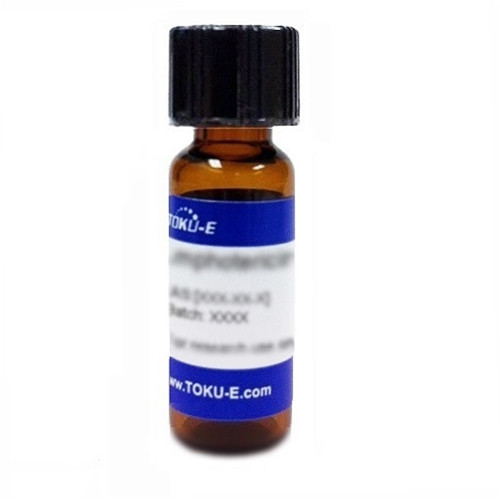Clindamycin is a broad-spectrum lincosamine antibiotic and antiparasitic agent. It is a semi-synthetic derivative of Lincomycin, a natural lincosamide from Streptomyces lincolnensis. It is obtained by chloride substitution of the exocyclic sugar hydroxy group for improved pharmacodynamics, and was first announced in 1966 by researchers Magerlein, Birkenmeyer and Kagan at the Interscience Conference on Antimicrobial Agents and Chemotherapy (ICAAC). Clindamycin is freely soluble in water.
We also offer:
| Mechanism of Action | Clindamycin has a bacteriostatic effect, acts by reversible binding to the 50S rRNA of the large bacterial ribosome subunit, preventing ribosomal translocation and thus protein synthesis. |
| Spectrum | Clindamycin has broad-spectrum activity against Gram-positive and Gram-negative anaerobic bacteria, in addition to protozoa. |
| Eukaryotic Cell Culture Applications | HIV-infected MOLT3 cells were incubated with increasing concentrations of Clindamycin and did not result in increased cell death compared to uninfected control cells (Wijsman et al, 2013).
The effects of Clindamycin and its metabolites on mammalian cell lines (mouse leukemia L1210, human oral carcinoma KB, human acute myelogenous leukemia RPMI 6410, and human lymphocyte RPMI 1788) were evaluated. Metabolites Clindamycin sulfoxide and clindamycoase were nontoxic, whereas N-demethyl Clindamycin showed cytotoxic effects in culture (Li LH et al (1977). Clindamycin in combinations with gentamicin, ciprofloxacin, or imipenem were tested in vitro. No cytotoxicity was seen when human and mouse fibroblasts and adipose derived stem cells (ADSCs) were exposed to collagen-rich hydrogels (cHG) plus the antibiotic cocktails (Sharma et al, 2024). |
| Microbiology Applications | When evaluating a Gram-positive culture for Clinamycin sensitivity, it is common to perform a 'D-test' to review for bacterial subpopulation with the iMLSB phenotype. This means bacteria are resistant to the macrolide-lincosamide-streptogramin B group of antibiotics, but the resistance mechanism is only induced by presence of 14-membered ring macrolides like erythromycin. Bacteria with this phenotype demonstrate erythromycin-induced resistance in vitro due to macrolide-inducible plasmid-encoded erm gene (Leclercq, 2002). |
| Molecular Formula | C18H33CIN2O5S |
| Solubility | Freely soluble in water. Soluble in ethanol, methanol, DMF and DMSO. |
| References |
Dhawan VK and Thadepalli H (1982) Clindamycin: A review of fifteen years of experience. Clin. Infect. Dis. 4(6):1133-1153 PMID 6818656 Leclercq R (2002) Mechanisms of resistance to macrolides and lincosamides: Nature of the resistance elements and their clinical implications. Clin Infect Dis. 34(4):482-492 PMID 11797175 Li LH, Kuentzel K L, Shugars KD and Bhuyan BK (1977) Cytotoxicity of several marketed antibiotics on mammalian cells in culture. J. Antibiot (Tokyo) 30(6):506-512 PMID 560364 Lovmar, M and Tanel T (2003) The mechanism of action of macrolides, lincosamides and streptogramin B reveals the nascent peptide exit path in the ribosome. J. Molec. Microbiol. 330(5 ): 1005-014 PMID 12860123 Magerlein BJ et al (1966) Chemical modification of lincomycin. Antimicrob Agents Chemother. 6:727 PMID 5985307 Wijsman JA, Dekaban GA and Rieder MJ (2013) Differential toxicity of reactive metabolites of Clindamycin and sulfonamides in HIV-infected cells: Influence of HIV infection on Clindamycin toxicity in vitro. J. Clin. Pharmacol. 45(3):346-351 PMID 15703369 |




